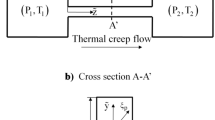Abstract
Analytical solutions for the pressure and the velocity profiles in a microchannel are derived from the quasi gasdynamic equations (QGD). An expansion method according to a small geometric parameter ɛ is undertaken to obtain the isothermal flow parameters. The deduced expression of the mass flow rate is similar to the analytical expression obtained from the Navier-Stokes equations with a second order slip boundary condition and gives results in agreement with the measurements. The analytical expression of the pressure predicts accurately the measured pressure distribution. The effects of the rarefaction and of the compressibility on pressure distributions are discussed. The numerical calculations based on the full system of the QGD equations were carried out for different sizes of the microchannels and for different gases. The numerical results confirm the validity of the analytical approach.












Similar content being viewed by others
References
Sharipov F (1999) Rarefied gas flow through a long rectangular channel. J Vac Sci Technol 17(5):3062–3066
Shen C, Fan J, Xie C (2003) Statistical simulation of rarefied gas flows in micro-channels. J Computational Phys 189:512–526
Tang GH, Tao WQ, He YL (2003) Gas flow study in MEMS using Lattice Boltzmann method. In: Kandlikar SG (ed) Proceeding of the first international conference on microchannels and minichannels. Rochester, pp 389–396
Prud’homme R, Chapman T, Bowen J (1986) Laminar compressible flow in a tube. Appl Sci Res 43:67–74
van den Berg HR, Seldam CA, van der Gulik PS (1993) Compressible laminar flow in a capillary. J Fluid Mech 246:1–20
Harley JC, Huang Y, Bau HH, Zemel YN (1995) Gas flow in micro-channels. J Fluid Mech 284:257–274
Arkilic EB, Schmidt MA, Breuer KS (1997) Gaseous slip flow in long microchannels. J Microelectromechanical Syst 6(2):167–178
Jie D, Diao X, Cheong KB, Yong LK (2000) Navier-Stokes simulations of gas flow in micro devices. J Micromech Microeng 10:372–379
Xue H, Fan Q (2000) A new analytic solution of the Navier-Stokes equations for microchannel flows. Microscale Thermophys Eng 4:125–143
Aubert C, Colin (2001) Hight order boundary conditions for gaseous flows in rectangular microchannels. Microscale Therm Eng 5(1):41–54
Karniadakis GE, Beskok A (2002) Microflow: fundamental and simulations. Springer, Berlin Heidelberg New York, p 340
Hadjiconstantinou NG (2003) Comment on cercignani’s second-order slip coefficient. Phys Fluids 15(8):2352–2354
Maurer J, Tabeling P, Joseph P, Willaime H (2003) Second-order slip laws in microchannels for helium and nitrogen. Phys Fluids 15(9):2613–2621
Arkilic EB, Breuer KS, Schmidt MA (2001) Mass flow and tangential momentum accomodation in silicon micromochined channels. J Fluid Mech 437:29–43
Elizarova TG, Graur IA, Lengrand JC, Chpoun A (1995) Rarefied gas flow simulation based on quasigasdynamic equations. AIAA J 33(12):2316–2324
Elizarova TG, Sheretov YuV (2001) Theoretical and numerical investigation of quasigasdynamic and quasihydrodynamic equations. Comput Math Math Phys 41(2):219–234
Elizarova TG, Sheretov YuV (2003) Analyse du probléme de l’ecoulement gazeux dans les microcanaux par les équations quasi hydrodynamique. La Houille Blanche (5):66–72
Graur IA, Méolans JG, Zeitoun DE (2004) Gaseous flows in the microchannels. In: Capitelly M (ed) Proceedings of 24th international symposium on rarefied gas dynamics, AIP Conference Proceedings, vol 762. Melville, New York, pp 755–760
Pong KC, Ho CM, Liu J, Tai YC (1994) Non-linear pressure distribution in uniform microchannels. In: Application of microfabrication to fluid mechanics. ASME, FED, vol 197, pp 51–56
Yao Z, He F, Ding Y, Shen M, Wang X (2004) Low-speed gas flow subchoking phenomenon in long-constant-area microchannel. AIAA J 42(8):1517–1521
Maté B, Graur IA, Elizarova TG, Chirokov IA, Tejeda G, Fernández JM, Montero S (2001) Experimental and numerical investigation of an axisymmetric supersonic jet. J Fluid Mech 426:177–197
Kogan MN (1969) Rarefied gas dynamics. Plenum Press, New York
Elizarova TG, Chirokov IA (1999) Macroscopic model for gas with translational-rotational nonequilibrium. J Comput Math Math Phys 39:135–146
Bird GA (1994) Molecular gas dynamics and the direct simulation of gas flows. Oxford University Press, New York
Gad-el-Hak M (2001) Flow physics in MEMS (review). Mec Ind 2:313–341
Schlichting H (1955) Boundary layer theory. Pergamon press, London
Sharipov F (2004) Data on the velocity slip and temperature jump coefficients. In: Ernst LJ, Zhang GQ, Rodgers P, de Saint Leger O (eds) Thermal and mechanical simulation and experiments in micro-electronics and micro-systems, 5th international conference of EuroSimE 2004. Shaker Publishing, pp 243–249
Cercignani C (1990) Mathematical methods in kinetic theory, 2nd edn, chap 4. Plenum, New York
Chapman S, Cowling TG (1970) The mathematical theory of non-uniform gases, 3rd edn. University Press, Cambridge
Deissler RG (1964) An analysis of second-order slip flow and temperature-jump boundary conditions for rarefied gases. Int J Heat Mass Transfer 7:681–694
Colin S, Lalonde P, Caen R (2004) Validation of a second-order slip flow model in rectangular microchannels. Heat Transfer Eng 25(3):23–30
Ohwada T, Sone Y, Aoki K (1989) Numerical analysis of the Poiseuille and thermal transpiration flows between two parallel plates on the basis of the Boltzmann equation for hard sphere molecules. Phys Fluids A 1(12):2042–2049
Graur IA (2001) Method of quasi-gasdynamic splitting for solving the Euler equations. Comput Math Math Phys 41(10):1506–1518
Dadzie SK, Meolans JG (2004) Anisotropic scattering kernel: generalized and modified Maxell boundary conditions. J Math Phys 45(5):1804–1819
Acknowledgements
The authors gratefully acknowledge the support for this work from the National Centre of Scientific Research (CNRS), project number MI2F03-45.
Author information
Authors and Affiliations
Corresponding author
Appendix A
Appendix A
If we take into account the second order terms in the logarithmic function expansion in the Taylor series (33), we obtain the second order approximation of the pressure distribution:
The corresponding pressure gradient for the second order approximation gives:
Rights and permissions
About this article
Cite this article
Graur, I.A., Méolans, J.G. & Zeitoun, D.E. Analytical and numerical description for isothermal gas flows in microchannels. Microfluid Nanofluid 2, 64–77 (2006). https://doi.org/10.1007/s10404-005-0055-6
Received:
Accepted:
Published:
Issue Date:
DOI: https://doi.org/10.1007/s10404-005-0055-6



